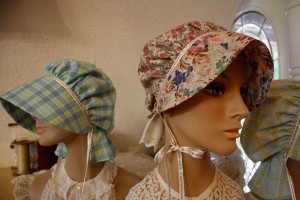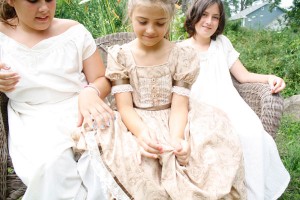ST. ALBANS — Put on those layers, tie up that corset and cover those ankles: it’s time to return to 1864, when fabric yardage, detailed accessories and propriety were at their height in St. Albans.

Bonnets made by St. Albans seamstress Cindy Leadbeater will be for sale during the weekend of the St. Albans Raid 150th Anniversary Commemoration to get in the spirit of 1864 fashion.
Civil war-era clothing is coming back in style in Franklin County, just in time for the St. Albans Raid 150th Anniversary Commemoration Sept. 18-21. Local residents young and old, re-enactors, visitors, history enthusiasts and even St. Albans City Mayor Liz Gamache are donning 19th-cenutry wear for the event.
As explained by Cambridge re-enactor Lynn Sawyer at a St. Albans St. Albans Raid Civil War dress presentation last year, clothing varied in the 1860s according to social status, gender, marriage status, age, and time of day.
In general, ladies wore large skirts, often with hoops, many undergarment layers, corsets, covering dresses that could be made out of a variety of fabrics from cheaper cotton to more expensive silk, plenty of accessories, and perhaps a cap, hat or bonnet. They may have also carried a parasol on sunny days.
Women’s clothes were often handmade and tailored individually, while men’s clothes, thanks to the need for mass production of military clothing during the Civil War that eventually spilled over to the civilian sector, were more readily available in standard sizes.

Cindy Leadbeater’s granddaughters, Amanda Powers, left, and Mya Belanger, right, both 11, show off some of the underpinnings Leadbeater has made to go along with the period outfits she has sewn.
Men experienced less variety in their clothing than women did, with styles changing more slowly than their feminine counterparts. A typical outfit consisted of flat-front trousers, boots or shoes, a roomy shirt, a vest, and a jacket. Facial hair was, in Sawyer’s words, a “free for all,” and straw, bowler, top and a variety of other hats were usually worn as well.
As many of these clothing types are, well, dated, men and women putting together period dress for the Raid Commemoration have to be a little creative. Outfits can be found on E-bay or made from scratch, with items both bought and found. In addition, local St. Albans seamstress Cindy Leadbeater has been putting together women’s and children’s dresses, undergarments, hats, jackets and vests for the past several months for those who have hired her services.
In addition, Leadbeater will sell cloth bonnets for those who’d like to get a taste of Civil War fashion during the Raid Commemoration weekend.
For people who have procured any amount of period clothes by mid-September, they’ll have the chance to show off their 1864 fashion throughout this fall’s commemoration of the northernmost land action in the Civil War. Local restaurants serving historical entrees, re-enactments, lectures, a parade and other activities will welcome the 1860’s outfits.
The most fashionable place to be that weekend, of course, will be at the Mayor’s Civil War Ball, where period or formal wear are required.
By ELODIE REED
St. Albans Messenger Staff Writer



